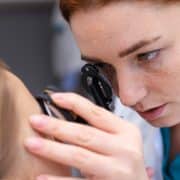Having LASIK Surgery?
Astigmatism, farsightedness, and nearsightedness are all refraction errors that require people to wear prescription eyeglasses or contact lenses. However, some people grow tired of wearing glasses or contacts over time and opt to have outpatient LASIK surgery. LASIK corrects the refraction error well enough for most people that they no longer need to wear contacts or glasses.
What Happens During LASIK Surgery?
When you have LASIK surgery, your eye surgeon reshapes the cornea of each eye with a laser. Most eye surgeons can complete the outpatient procedure in less than 30 minutes. Below is what you can expect if you opt for the LASIK procedure.
- Your eye surgeon places numbing drops in your eyes to ensure that you remain comfortable.
- The surgeon working on your eyes places an eyelid speculum and suction ring on each eye. This is not painful. The speculum and suction ring keep your eyes in a steady position and prevent you from blinking.
- The surgeon creates a thin flap in each of your corneas.
- You look at light aimed at your eyes while the eye surgeon reshapes your corneas with a laser.
- Your eye doctor puts the corneal flaps back in place. The cornea should reattach immediately.
Although we do not perform LASIK surgery at Dr. Jan Eye Care, we do offer LASIK co-management services in Elkridge MD to ensure that you receive the best care before and after the procedure.
What Are LASIK Co-Management Services?
Prior to your surgery, Dr. Jan will conduct a thorough eye exam, ask questions about your medical history, and perform any diagnostic tests you need before your LASIK surgery. Eye surgeons who perform this surgery have completed extensive training to become ophthalmologists.
Your care transfers back to Dr. Jan after the completion of your surgery. Your optometrist and ophthalmologist work together to keep you safe, comfortable, and to make sure that healing takes place as expected.
Interested in Learning More About LASIK?
Whether you are considering this procedure or want to know more about LASIK co-management services in Elkridge MD, we encourage you to reach out to request an exam at Dr. Jan Eye Care. We look forward to teaming up with a local ophthalmologist to help you see the world more clearly.





